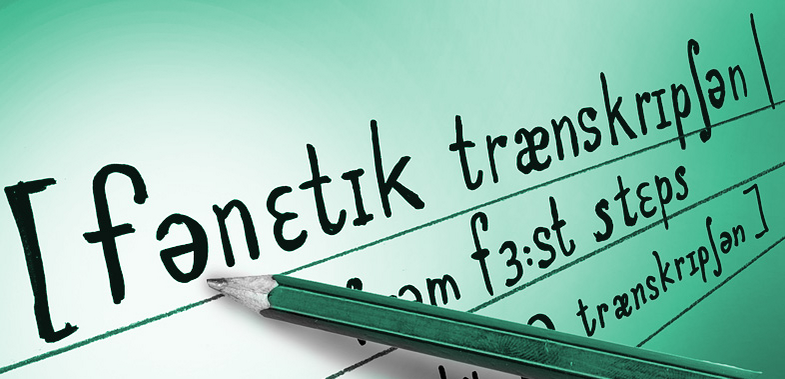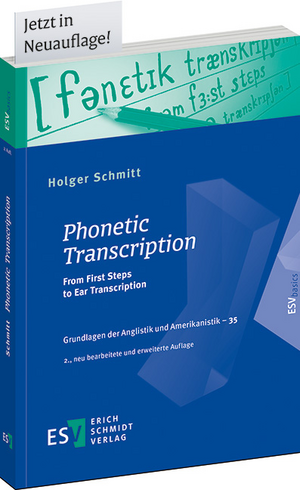
Vom Klang zum Zeichen: Phonetische Transkription
The Standard Lexical Set
In 1982, John Wells, famous British dialectologist and phonetician, published his seminal three-volume work Accents of English, for many years a standard work on variation and world varieties of English. In it, Wells introduced what he referred to as the ‘Standard Lexical Set’. These are words, printed in small capitals, which represent all the words that share the same vowel. Thus, for example, the FLEECE set contains words like knee, mean, key, people etc., regardless of their spelling. However, these words can also be used to refer to the vowels used in the words themselves. It is, for instance, easier to talk about ‘the TRAP vowel in RP’ than to imitate it, describe it phonetically (‘the short mid-low to low front vowel’) or to describe the shape of the IPA symbol that represents it (‘the symbol that looks like, erm, a cross between an x and an 8’). Here are the key words and their corresponding symbols as they are used in this book for Received Pronunciation (for General American see below); we will introduce one set that Wells did not use (the inflUence words).
FLEECE KIT DRESS TRAP STRUT NURSE LOT BATH
iː ɪ ε ӕ ʌ ɜː ɒ ɑː
THOUGHT FOOT GOOSE PRICE MOUTH FACE CHOICE GOAT
ɔː ʊ uː aɪ aʊ εɪ ɔɪ әʊ
NEAR CURE SQUARE happY inflUence commA
ɪә ʊә εә i u ә
The last three of these sounds are not considered to be phonemes of English, and we will introduce the happY and inflUence vowels only in section B. The sound in commA is commonly referred to as schwa. The term comes from Hebrew, and the sound is used in many languages of the world, often as a reduced vowel in unstressed syllables.
[…]
The choice of symbols
Strange as it may seem for someone who has never dealt with the question of which symbols are to be used to transcribe a particular sound, transcribers always need some principles to guide them through the process. In this book, we follow three basic principles in sections A and B (cf. IPA 1999: 159 f.):
- The major principle is, of course, the phonemic principle. If there are two sounds in an accent that potentially distinguish words, different symbols must be used.
- Second, the symbols we employ are those that correspond closest to the actual realisation of the sound in question. This is one of the reasons why we use the epsilon symbol for the DRESS, SQUARE and FACE sets both for RP and GA [Received Pronunciation and General American] and [ir] for NEAR in GA. However, we avoid diacritics. Thus, we neither use symbols like [ɚ] (the ‘r-colored schwa’ as in GA winner) or [ɝː] (as in nurse) in the transcription of GA nor do we mark consonants as syllabic in syllables that have no vowel (as in [hɪdn̩], hidden). Exceptions to this rule would be the length mark [ː], which is employed both for RP and GA, and the voicing symbol [˯], which we use for GA [t̬].
- Third, established conventions are respected wherever possible. This is reflected by the fact that, in RP, the STRUT vowel is not transcribed as [ɐ] and the FACE, PRICE and MOUTH diphthongs do not feature as [εe], [ae] or [ao] either, nor GOOSE as [ʉː], even though these transcriptions would possibly reflect actual present-day pronunciations more accurately than the established ones. Compare, for example, the diphthong in mail with the monophthong [eː] in the German word Mehl. Unless you pronounce the former very carefully and slowly, you will find that the endpoint of the diphthong in mail is only around the same height as the vowel in Mehl – possibly even lower. However, there is a firmly established tradition of transcribing FACE and PRICE with [ɪ] and MOUTH with [ʊ] as endpoints, probably due to the fact that speakers aim for these vowels but, in actual speech, move on to the next sound before they have actually reached them (a phenomenon referred to as vowel undershoot, cf. Reetz & Jongman 2009: 252). Also, in American English, words like latter and ladder are virtually homophonous. Thus, theoretically, these two words could be transcribed as [ˈlӕdr], and some transcribers actually follow this pattern. However, many textbook writers employ a different policy; since the [d] would be a phoneme in ladder but an allophone in latter, they would use [t̬] for (the) latter. This convention is widely in use, and we follow it here, too.
| Nachgefragt bei PD Dr. Holger Schmitt | 21.03.2025 |
| „Phonetische Transkription schärft das Bewusstsein für die englische Aussprache“ | |
 |
Obgleich phonetische Transkription für Studierende der englischen Philologie unabdingbar ist, ist sie nicht immer leicht zu verstehen. Welchen Herausforderungen sehen sich Lernende gegenüber und wie lassen sich diese überwinden? Dr. Holger Schmitt geht diesen Fragen auf den Grund und gibt einen Einblick in die Welt der Lautschrift. mehr … |
Some practical advice
Students often struggle with similar problems when they start transcribing. The following tips are meant to help you get started and avoid some of the commonest mistakes.
- If you’ve got the choice between GA and RP, choose one variety and stick with it. It is important that you have a reference accent with which you can compare other accents or actual speech later on. Remember that GA is less fixed than RP, which may make transcription slightly more complicated.
- Initially, you will probably use spelling as a guideline. In some cases (particularly in the question of TRAP vs. DRESS in RP), this can be a help. Generally, however, the English spelling is notoriously unreliable or even misleading. As you practise transcription, set your mind on losing your orientation towards spelling and get used to ‘listening’ to your ‘inner voice’.
- You will probably find that transcribing most consonants is not a big problem. The sound [m], for example, is usually represented either by <m> or <mm> in many Indo-European languages, and the International Phonetic Alphabet reflects this fact by using this letter as a symbol for this sound. However, many students find it somewhat difficult to distinguish the dental fricatives [ð] and [θ] and, perhaps, the alveolar fricatives [z] and [s]. These consonants will receive special attention in sections A and B.
- Many students, however, find it difficult to identify vowels. For example, is the vowel in the second syllable of captain a schwa, or is it the same as the one in DRESS, FACE or KIT? And what about the stressed syllable of because? Is this vowel like the one in LOT or in THOUGHT? Or could it even be either? For this reason, and because every word has at least one vowel, it might be a good idea to memorise a word for each vowel phoneme with which you can compare the word that you are trying to transcribe. A useful set of words is the one provided in the ‘Standard Lexical Set’ section above, since these words have come to be used internationally to compare different accents. In other words, if you attend classes on variation later on in your studies (e.g. sociolinguistics, varieties of English), you are likely to come across these terms again anyway. In the Practice section below, the vowels will be briefly characterised, followed by examples of typical graphemic representations. You will then find a few words with rather unusual spellings for this vowel. These examples are by no means exhaustive; they only list a few words which are still fairly common in English but whose spelling is a bit off the beaten track (As was mentioned above, spelling-sound correspondences multiply if you include foreign (esp. French) loanwords and alternative pronunciations.).
- […]
- Strictly speaking, the correct symbol that indicates length is two triangle-like figures that point at each other, thus: ‘ː’, and this is how length is indicated in this book. However, even many linguists employ simple colons for ease of use, and you may be forgiven if you do the same.
- If you struggle with the transcription of a longer word, look out for the syllable that receives the main stress first. Mark it with the symbol ˈ at the beginning (as in [əˈraɪv] for arrive). Since this syllable cannot be weak (i.e. reduced to schwa), try to identify the vowel or diphthong here. Then ask yourself if there is another full vowel in the word which receives secondary stress. In most words (with the exception of compounds), this will precede the syllable with the primary stress.
- Last but not least, one piece of advice is particularly true for transcription: practice makes perfect. If you have learned to spell English words, transcription should not be such a challenge since you have a rough idea of the pronunciation of a word anyway. As a guideline, you need approximately 20–30 hours of practice to be reasonably proficient in broad phonetic transcription; ear transcription (section C), of course, takes a lot longer.
Sie sind neugierig, wie es weitergeht? Der Titel kann hier bestellt werden.
| Zum Autor |
| Holger Schmitt taught English linguistics at five German universities. His areas of specialization include applied phonetics and phonology, sociolinguistics and corpus linguistics. |
 |
Phonetic Transcription. From First Steps to Ear Transcription Von Holger Schmitt
The second edition has been revised, partially updated and extended, with the key now being provided in the book for both British and American pronunciation for all relevant exercises. |
Programmbereich: Anglistik und Amerikanistik
